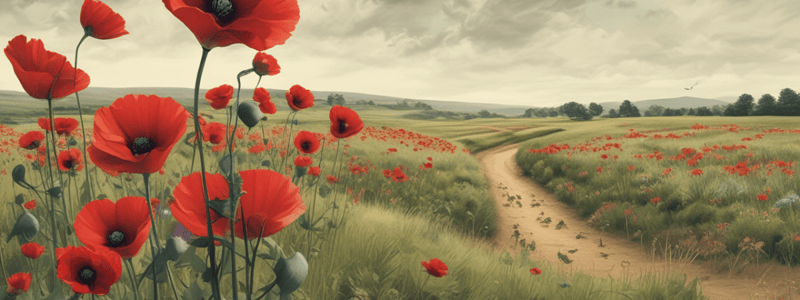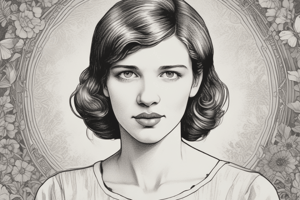Podcast
Questions and Answers
What is the significance of the poppy seeds in the poem?
What is the significance of the poppy seeds in the poem?
- They represent the poet's love for flowers
- They are associated with the production of opiate-based drugs (correct)
- They are a reminder of the beauty of nature
- They symbolise hope and resilience
How does the use of caesura contribute to the poem's effect?
How does the use of caesura contribute to the poem's effect?
- It creates a sense of urgency and chaos
- It adds a sense of rhythm and musicality
- It distracts from the poem's themes
- It emphasises the poet's inability to access the flower (correct)
What is the tone of the line 'I put my hands among the flames. Nothing burns'?
What is the tone of the line 'I put my hands among the flames. Nothing burns'?
- Playful and carefree
- Sinister and disturbing (correct)
- Serious and reflective
- Hopeful and optimistic
What is implied by Plath's phrase 'it exhausts me'?
What is implied by Plath's phrase 'it exhausts me'?
What is the significance of the image of 'little bloody skirts'?
What is the significance of the image of 'little bloody skirts'?
What does Plath seem to desire from the poppies?
What does Plath seem to desire from the poppies?
What is the effect of the assonance in 'dulling' and 'stilling'?
What is the effect of the assonance in 'dulling' and 'stilling'?
What is the tone of the final line 'But colorless. Colorless.'?
What is the tone of the final line 'But colorless. Colorless.'?
Flashcards
Poppy Seeds Significance
Poppy Seeds Significance
Poppy seeds in the poem symbolize the production of opiate-based drugs.
Caesura's Effect
Caesura's Effect
Caesura in the poem highlights the poet's struggles to fully grasp the flower's meaning.
Tone of "I put..." line
Tone of "I put..." line
The line 'I put my hands among the flames. Nothing burns' conveys a disturbing and sinister tone.
"It exhausts me" Implication
"It exhausts me" Implication
Signup and view all the flashcards
"Little bloody skirts" Significance
"Little bloody skirts" Significance
Signup and view all the flashcards
Plath's Desire from Poppies
Plath's Desire from Poppies
Signup and view all the flashcards
Assonance Effect ("dulling," "stilling")
Assonance Effect ("dulling," "stilling")
Signup and view all the flashcards
Tone of "But colorless..."
Tone of "But colorless..."
Signup and view all the flashcards
Study Notes
Themes and Ideas
- The poem "Poppies in July" explores the theme of self-harm and the desire to feel numb due to depression
- Mental health is a prominent theme, with the speaker expressing a desire to escape their suffering
- Nature is presented as a potential source of respite from the speaker's emotional pain
- The poem also touches on the idea of the female experience, with references to miscarriage and violence
Style
- The poem features a musical rhythm that contrasts with the disturbing content
- Repetition is used to create a sense of rhythm and musicality
- Caesura is used to convey the speaker's desperation and frustration
- Provocative imagery is used throughout the poem, including comparisons of poppies to "hell flames" and "little bloody skirts"
- Simile, synecdoche, and alliteration are also employed to create vivid and disturbing images
Analysis of Key Quotes
- The opening lines "Little poppies, little hell flames, / Do you do no harm?" introduce the theme of self-harm and the speaker's desire to escape their suffering
- The use of fire imagery, including "flames" and "burns", conveys the speaker's desire for physical pain as a distraction from emotional turmoil
- The lines "You flicker. I cannot touch you. I put my hands among the flames. Nothing burns" suggest the speaker's sense of desperation and frustration
- The image of the poppy petals being compared to "the skin of a mouth" is sensual and almost erotic, highlighting the speaker's attraction to the flowers
- The poem's violent imagery, including "a mouth just bloodied" and "little bloody skirts", is uncomfortable and confrontational
- The final lines "Or your liquors seep to me, in this glass capsule, / Dulling and stilling. / But colorless. Colorless" convey the speaker's sense of hopelessness and desperation
Studying That Suits You
Use AI to generate personalized quizzes and flashcards to suit your learning preferences.




